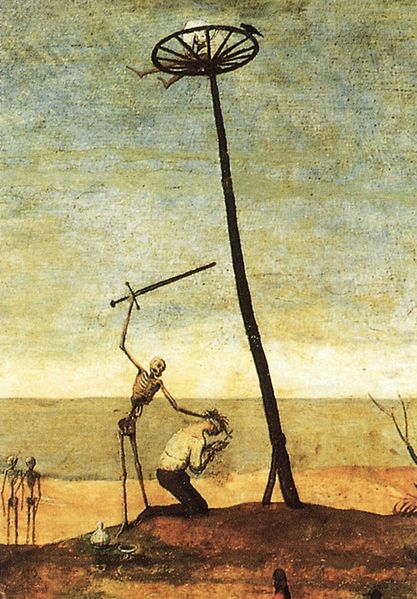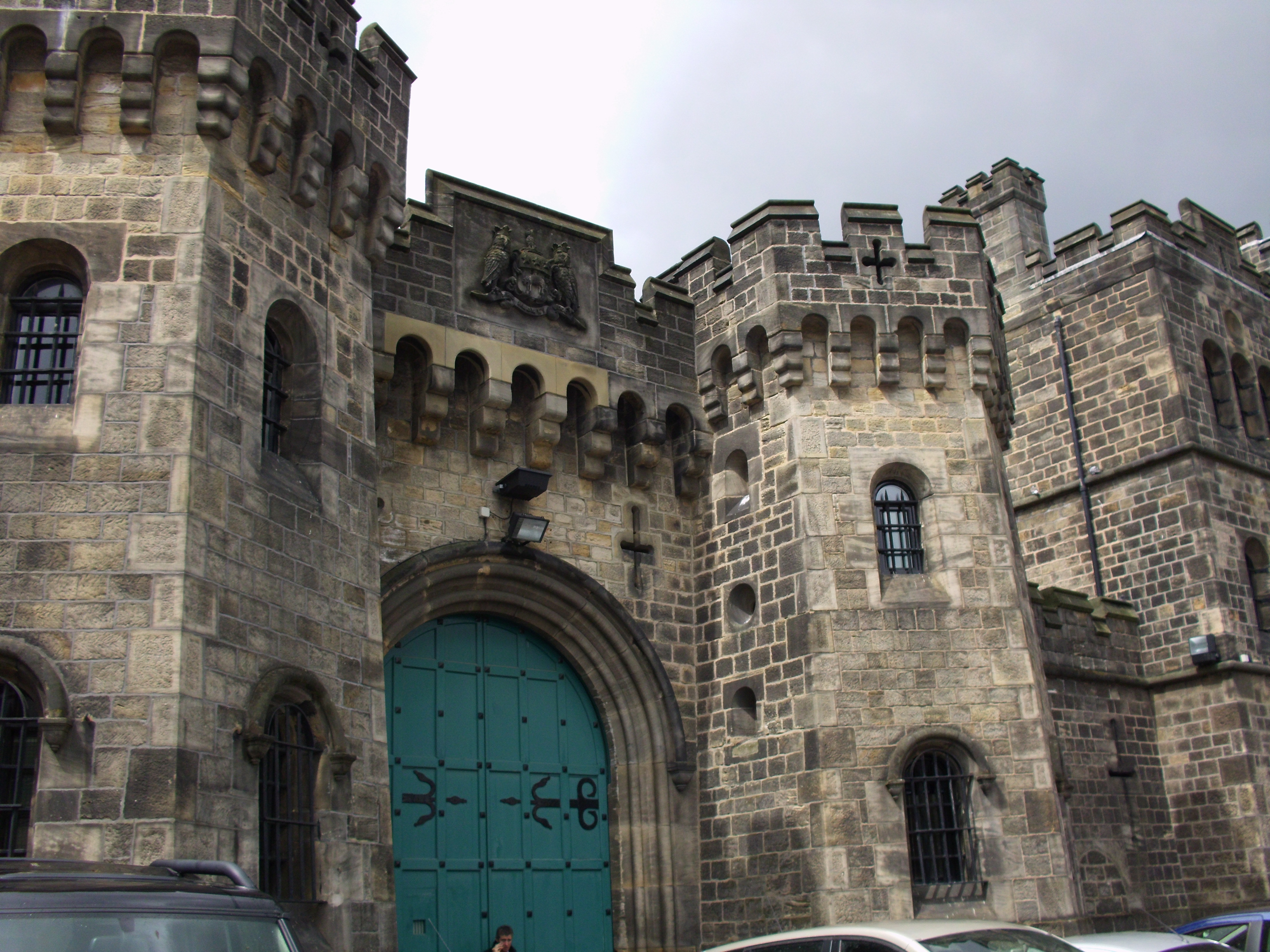|
Stephen Wade (executioner)
Stephen Wade (14 December 1887 – 22 December 1956) was one of England's executioners from 1940 until 1955. He assisted Tom and Albert Pierrepoint on 31 occasions and also carried out 28 executions as principal executioner. One of his first assignments was on 31 October 1942, assisting Albert Pierrepoint in his first execution as a senior, that of Antonio Mancini at HMP Pentonville. After the Second World War he worked for a time at a coach dealership in his home town of Doncaster. His first execution as principal executioner was the hanging of Arthur Charles at HMP Durham on 26 March 1946. Following this, he was usually selected by the Sheriff of Yorkshire for executions at HMP Armley from 1947 onwards. The execution of Walter Sharpe (aged 20) took place at the prison on 30 March 1950, when he was assisted by Harry Allen. His final assignment was the execution of Alec Wilkinson (aged 22), whom he hanged at Leeds on 12 August 1955. Wade's assistant at this executi ... [...More Info...] [...Related Items...] OR: [Wikipedia] [Google] [Baidu] |
Executioner
An executioner, also known as a hangman or headsman, is an official who executes a sentence of capital punishment on a legally condemned person. Scope and job The executioner was usually presented with a warrant authorising or ordering him to ''execute'' the sentence. The warrant protects the executioner from the charge of murder. Common terms for executioners derived from forms of capital punishment—though they often also performed other physical punishments—include hangman (hanging) and headsman (beheading). In the military, the role of executioner was performed by a soldier, such as the ''provost''. A common stereotype of an executioner is a hooded medieval or absolutist executioner. Symbolic or real, executioners were rarely hooded, and not robed in all black; hoods were only used if an executioner's identity and anonymity were to be preserved from the public. As Hilary Mantel noted in her 2018 Reith Lectures, "Why would an executioner wear a mask? Everybody k ... [...More Info...] [...Related Items...] OR: [Wikipedia] [Google] [Baidu] |
Thomas Pierrepoint
Thomas William Pierrepoint (6 October 1870 – 11 February 1954) was an English executioner from 1906 until 1946. He was the brother of Henry Pierrepoint and uncle of Albert Pierrepoint. Personal life Pierrepoint was born in Sutton Bonington, Nottinghamshire, in 1870, the second child and eldest son of Thomas Pierrepoint, a plate layer on the railway, and Ann Pierrepoint, formerly Marriott. The Pierrepoint family were still living in Sutton Bonington at the time of the 1881 census, 1881 census: Sutton Bonington; RG11; Piece 3149; Folio 26; Page 3. but by the 1891 census they had moved to Clayton, near Bradford, Yorkshire, where Thomas and his father were employed as stone quarrymen. He was married to Elizabeth Binns on 5 December 1891. By 1914, Pierrepoint had taken on a number of "sidelines", including a carrier service founded by his brother, a small farm, and an illegal bookmaking business. Career Thomas Pierrepoint began working as a hangman in 1906 under the influenc ... [...More Info...] [...Related Items...] OR: [Wikipedia] [Google] [Baidu] |
Albert Pierrepoint
Albert Pierrepoint (; 30 March 1905 – 10 July 1992) was an English hangman who executed between 435 and 600 people in a 25-year career that ended in 1956. His father Henry and uncle Thomas were official hangmen before him. Pierrepoint was born in Clayton in the West Riding of Yorkshire. His family struggled financially because of his father's intermittent employment and heavy drinking. Pierrepoint knew from an early age that he wanted to become a hangman, and was taken on as an assistant executioner in September 1932, aged 27. His first execution was in December that year, alongside his uncle Tom. In October 1941 he undertook his first hanging as lead executioner. During his tenure he hanged 200 people who had been convicted of war crimes in Germany and Austria, as well as several high-profile murderers—including Gordon Cummins (the Blackout Ripper), John Haigh (the Acid Bath Murderer) and John Christie (the Rillington Place Strangler). He undertook several conten ... [...More Info...] [...Related Items...] OR: [Wikipedia] [Google] [Baidu] |
HMP Pentonville
HM Prison Pentonville (informally "The Ville") is an English Category B men's prison, operated by His Majesty's Prison Service. Pentonville Prison is not in Pentonville, but is located further north, on the Caledonian Road in the Barnsbury area of the London Borough of Islington, north London. In 2015 the justice secretary, Michael Gove, described Pentonville as "the most dramatic example of failure" within the prisons estate. The prison today Pentonville is a local prison, holding Category B/C adult males remanded by local magistrates' courts and the Crown Court, and those serving short sentences or beginning longer sentences. The prison is divided into these main wings: * A wing: Remand and convicted * J wing: Induction wing * C wing: Remands and convicted prisoners * D wing: Remands and convicted * E wing: Remands and convicted * F wing: Detoxification Unit (F4 F5 Vulnerable Prisoners) * G wing: remands and convicted (G5 enhanced only) G wing has an education department, ... [...More Info...] [...Related Items...] OR: [Wikipedia] [Google] [Baidu] |
Coach (bus)
A coach (or coach bus/motorcoach) is a type of bus built for longer-distance service, in contrast to transit buses that are typically used within a single metropolitan region. Often used for touring, intercity, and international bus service, coaches are also used for private charter for various purposes. Coaches are also related and fall under a specific category/type of RVs. Deriving the name from horse-drawn carriages and stagecoaches that carried passengers, luggage, and mail, modern motor coaches are almost always high-floor buses, with separate luggage hold mounted below the passenger compartment. In contrast to transit buses, motor coaches typically feature forward-facing seating, with no provision for standing. Other accommodations may include onboard restrooms, televisions, and overhead luggage space. History Background Horse-drawn chariots and carriages ("coaches") were used by the wealthy and powerful where the roads were of a high enough standard from p ... [...More Info...] [...Related Items...] OR: [Wikipedia] [Google] [Baidu] |
Doncaster
Doncaster (, ) is a city in South Yorkshire, England. Named after the River Don, it is the administrative centre of the larger City of Doncaster. It is the second largest settlement in South Yorkshire after Sheffield. Doncaster is situated in the Don Valley on the western edge of the Humberhead Levels and east of the Pennines. At the 2021 census, the city had a population of 308,100, while its built-up area had a population of 158,141 at the 2011 census. Sheffield lies south-west, Leeds north-west, York to the north, Hull north-east, and Lincoln south-east. Doncaster's suburbs include Armthorpe, Bessacarr and Sprotbrough. The towns of Bawtry, Mexborough, Conisbrough, Hatfield and Stainforth, among others, are only a short distance away within the metropolitan borough. The towns of Epworth and Haxey are a short distance to the east in Lincolnshire, and directly south is the town of Harworth Bircotes in Nottinghamshire. Also, within the city's vicinity are Barnsley, ... [...More Info...] [...Related Items...] OR: [Wikipedia] [Google] [Baidu] |
HMP Durham
HM Prison Durham is a Georgian era reception Category B men's prison, located in the Elvet area of Durham in County Durham, England. Built in 1819, the prison continues to be operated by His Majesty's Prison Service. Women prisoners were moved in 2005 due to overcrowding and suicides. History Durham Prison was built in 1810, consisting of some 600 cells and took its first prisoners in 1819. It is adjacent to Durham's Crown Court centre. The prison has held a variety of different categories of prisoners, both male and female over the course of its history. Between 1869 and 1958, 95 judicial executions took place on the gallows at Durham prison or the court house. In 1832, protests over working conditions in the South Shields workhouse were supported by miner strikes. Soldiers were sent to evict striking miners from their pubs. One miner, William Jobling, was convicted of the murder of a local magistrate near Jarrow Slake. He was hanged amid heightened security of 50 mounted H ... [...More Info...] [...Related Items...] OR: [Wikipedia] [Google] [Baidu] |
Leeds (HM Prison)
HM Prison Leeds is a Category B men's prison, located at Gloucester Terrace in the Armley area of Leeds in West Yorkshire, England, which opened in 1847. Leeds Prison is operated by His Majesty's Prison Service, and is still known locally as Armley Gaol, the historical name for the prison. History Construction of Leeds Prison (originally named Leeds Borough Gaol) was completed in 1847. Built from locally quarried stone, the prison originally had four wings radiating from a central point in a Victorian architectural style (known as 'radial') typical of the time. Each of these four wings had three landings of cells. Eventually Armley Gaol was renamed along with other prisons to make their locations more obvious to people unfamiliar with these areas. The prison was a site of execution (by hanging) from 1847 until 1961. The final execution was that of Zsiga Pankotia, by Harry Allen for the murder of Jack Eli Myers in a house burglary in the city's affluent Roundhay district. T ... [...More Info...] [...Related Items...] OR: [Wikipedia] [Google] [Baidu] |
Harry Allen (executioner)
Harry Bernard Allen (5 November 1911 – 14 August 1992) was one of Britain's last official executioners, officiating between 1941 and 1964. He was chief executioner at 41 executions and acted as assistant executioner at 53 others, at various prisons in England, Scotland, Northern Ireland, the Channel Islands and Cyprus. He acted as assistant executioner for 14 years, mostly to Albert Pierrepoint from 1941 to 1955. In October 1955 Allen was appointed as Chief Executioner alongside Pierrepoint, although he did not execute anyone in this role until 10 May 1956, when he hanged two EOKA members in Cyprus. Pierrepoint was no longer available because he had resigned in February 1956. Allen's most controversial hanging came in April 1962, when James Hanratty was hanged for murder, despite efforts to clear his name. Hanratty was proven guilty in 2002 by DNA. Allen also assisted in the execution of Derek Bentley in 1953, and he performed one of the last two executions in Britain, in ... [...More Info...] [...Related Items...] OR: [Wikipedia] [Google] [Baidu] |
Hanged
Hanging is the suspension of a person by a noose or ligature around the neck.Oxford English Dictionary, 2nd ed. Hanging as method of execution is unknown, as method of suicide from 1325. The ''Oxford English Dictionary'' states that hanging in this sense is "specifically to put to death by suspension by the neck", though it formerly also referred to crucifixion and death by impalement in which the body would remain "hanging". Hanging has been a common method of capital punishment since medieval times, and is the primary execution method in numerous countries and regions. The first known account of execution by hanging was in Homer's ''Odyssey'' (Book XXII). In this specialised meaning of the common word ''hang'', the past and past participle is ''hanged'' instead of ''hung''. Hanging is a common method of suicide in which a person applies a ligature to the neck and brings about unconsciousness and then death by suspension or partial suspension. Methods of judicial hanging Ther ... [...More Info...] [...Related Items...] OR: [Wikipedia] [Google] [Baidu] |






